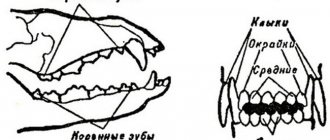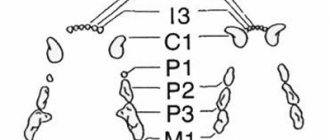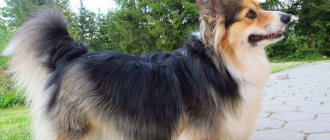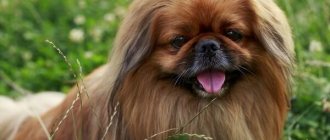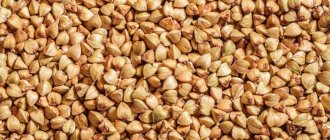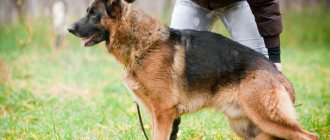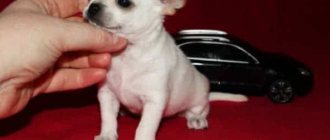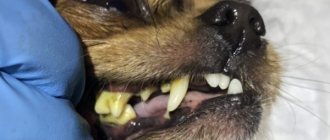A puppy's tooth falls out - this is a natural change from baby teeth to permanent ones. But if this happens in an adult, but not an old dog, then this can no longer be called normal. Why does a dog's teeth fall out? And what to do in such a situation? Let's find answers to these questions.
Why is your dog's teeth falling out?
Tooth loss most often depends on the following reasons: - poor nutrition: most often it is an unbalanced diet that lacks vitamins and beneficial microelements; - the diet consists mainly of food of soft consistency, which does not allow the teeth to clean themselves; - lack of natural stress on them: improper walks, no opportunity to chew something, etc.; — no care for the pet’s jaw; - liver diseases and worms.
Normal teeth by age
Adults
Normally, an adult dog's permanent bite consists of 42 teeth, the formula of which should look like this:
- Upper jaw: 2M 4P 1C 3I 3I 1C 4P 2M
- Lower jaw: 3M 4P 1C 3I 3I 1C 4P 3M, where:
- M - molars
- P - premolars
- C - fang
- I - incisors.
We get 20 teeth on the upper jaw and 22 on the lower jaw.
It is worth taking into account the breed characteristics of the skull. Brachycephals may have a lack of teeth, while dolichocephals (breeds with a very long muzzle, such as collies), on the contrary, may have too many. Such cases cannot be called the norm; these are simply features due to the skull.
Puppies
Puppies are born without any teeth. The first to begin to emerge are the temporary ones, or more simply put, the deciduous incisors and fangs. This occurs at 3–4 weeks of life. Then, from the fourth to the twelfth week, the “baby” premolars erupt and grow. Puppies do not have molars.
From twelve weeks until teeth change, the puppy’s formula looks like this:
- Upper jaw: 3P 1C 3I 3I 1C 3P
- Lower jaw: 3P 1C 3I 3I 1C 3P
14 teeth each in the upper and lower jaws.
The replacement of temporary teeth with permanent ones begins at three months.
At 3-5 months, the incisors completely change.
From 4 to 6 months, a complete change of incisors and premolars occurs.
And in 5-7 months molars appear.
If a puppy older than seven months still has baby teeth, take the dog to the vet.
How to make life easier for a “toothless” pet: tips
But how can you make life easier for a “toothless” pet, if for some reason the dog has lost some (or even all) of its teeth? Veterinarians and experienced breeders give the following advice:
- You will have to completely reconsider your diet. No bones, dry food or other variations of hard food. Of course, the severity of this restriction is inversely proportional to the number of teeth remaining in the animal. Simply put, if a dog has lost two premolars, then there is nothing wrong with that; the diet can be left practically unchanged. But if 1/3 or more of your teeth fall out, it will have to be completely revised.
- High-quality canned food becomes the main source of nutrition. If the animal is already aged, the ideal solution would be specialized veterinary holistic services for old dogs.
- To minimize the risk of digestive problems, it is necessary to use probiotics or foods with dietary fiber from time to time.
Causes of tooth loss in puppies and adults
Puppies have baby teeth for up to seven months and it is normal for them to fall out.
If the dog already has a completely permanent bite, and you notice that teeth are falling out, this is always an alarming sign and a reason to consult a veterinarian as soon as possible.
Tooth loss signals a pathological process in the dog’s body, and this is not always associated exclusively with the oral cavity.
The main reasons leading to tooth loss:
- Poor nutrition . An incorrectly formulated diet (or more often it is simply feeding from the table) is the root cause of many health problems, and oral health is no exception. Remember, your dog needs solid food! Since in the process of gnawing it, the teeth are naturally cleansed of food debris and plaque. Under no circumstances should a dog be given tubular bones. Feeding only soft foods leads to the formation of tartar, which negatively affects the condition of the tooth.
- Lack of oral hygiene.
- Oral diseases . These include:
- Gingivitis is inflammation of the gums.
- Periodontitis is an inflammation of the gums and dental follicles, affecting all surrounding tissues. The roots of the teeth are exposed.
- Pulpitis is inflammation of the dental canal (pulp).
- Stomatitis is an inflammation of the oral mucosa.
- Caries is the putrefactive destruction of hard tissues with the formation of a cavity in the affected teeth.
- Improper jaw development. This may be genetically determined, or may occur due to the lack of necessary load on the jaw. Frequent pathologies:
- Overshot - the lower jaw protrudes slightly forward relative to the upper jaw. For the Shih Tzu, Bull Terrier, Pekingese, and Boxer breeds, this phenomenon is the norm, but for other breeds it is a deviation.
- Underbite is, on the contrary, a deviation of the lower jaw backward relative to the upper jaw. If you notice this in a puppy, then most likely, after changing the teeth, everything will “fall into place.”
- Jaw misalignment is a pathology in which one of the jaws is larger than the other.
- Metabolism-related diseases . These may be hypovitaminosis, hypervitaminosis (lack or excess of vitamins), lack of macro and microelements.
- Diseases of organ systems:
- Kidney pathologies.
- Liver diseases.
- Problems in the gastrointestinal tract.
Associated symptoms that help determine the cause of the problem
If your dog has loose teeth, you need to pay attention to the accompanying symptoms. It is from them that you can make a preliminary diagnosis and understand how dire the current situation is:
- unpleasant odor, small holes, brown or black spots on the enamel – caries;
- sharp pain when biting, the presence of fistulas, swelling of the gums and muzzle - periodontitis;
- pain on palpation, chewing strictly on one side and refusal of cold food - pulpitis;
- increased salivation, redness of the mucous membranes and a brown-white coating on the tongue - stomatitis;
- bleeding during meals, the presence of small ulcers in the mouth - gingivitis;
- exposure of roots, leakage of pus and inflammation of the submandibular nodes - periodontitis;
- curvature of the bite, swelling and the appearance of blood from the mouth and nose - injury;
- the presence of suspicious growths in the oral cavity, sudden weight loss, oral bleeding - malignant neoplasms.
If you notice these symptoms, be sure to seek help. Tests will be required to determine the exact cause. Until this moment, you can only alleviate the pet’s condition by revising its diet to a more gentle one.
Symptoms
You may not even notice teeth falling out; dogs usually swallow them. As a rule, owners notice problems with the oral cavity when the pathological process is already in full swing and more than one tooth is already suffering.
Since the oral cavity suffers when teeth fall out, the symptoms are always the same. But there are also distinctive features depending on the reason. Now let's take a closer look.
Symptoms of oral diseases
Determining what kind of inflammation in the mouth is possible only with a thorough examination of the oral cavity, but the signs that owners notice are common to all:
- Partial refusal to eat, eats without appetite. He may even growl while he eats (due to pain in his gums).
- Bad breath.
- Bleeding from the mouth may be observed while eating.
- Profuse drooling.
- Swelling of the mouth (in some cases it is not observed, but in others the swelling extends to the muzzle).
Usually, only after the above symptoms, the owners look into the dog’s mouth, and then they notice that its teeth are falling out. In addition, you can see accompanying symptoms:
- Swelling and redness of the gums.
- Exposed tooth roots.
- Blueness between teeth.
- Ulcers on the gums.
- With pulpitis, you may notice that the color of the diseased tooth is different from the rest (dull, grayish, sometimes pinkish).
If teeth fall out due to metabolic disorders, then the initial symptoms look a little different:
- The quality of wool deteriorates.
- In young dogs, bone growth is impaired.
- Weight loss.
- Lethargy.
And soon after this, either inflammation of the oral cavity appears, or the quality and strength of the teeth themselves deteriorate. As a result, we see lost teeth.
In cases where the cause of lost teeth is a pathology in the development of the jaw, then everything is clearly visible.
Risk group by breed
The risk group includes small representatives of decorative breeds. With a normal dentition size, their jaw is more compact in size and has thin bone. Such animals include:
- Spitz;
- toy terriers;
- chihuahua;
- Yorkies;
- Pekingese;
- Japanese chins.
In addition to the genetic predisposition to the listed pathologies, such pets often suffer from persistence - an unusual anomaly in which both dentitions are preserved. This problem can only be solved surgically.
Diagnostics
When you take your dog to the vet, diagnosis always begins with a history.
Be prepared to answer questions like these:
- When and what alerted you, what were the first symptoms you noticed?
- Tell us everything about your pet's nutrition.
- Have you noticed a preference for softer foods?
- Do you give your dog a hygienic teeth cleaning? If so, what is used for this?
- Smell from the mouth?
- Lately, has the dog opened its mouth reluctantly, with effort, or normally?
The next step is inspection.
- The doctor looks at the general condition of the dog: coat quality, fatness, behavior.
- Inspection of the mouth.
- Counting the number of teeth.
- Bite assessment, taking into account breed characteristics.
- Definition of permanent and temporary (baby) teeth.
- Assessment of the condition of the gums and oral mucosa.
Sometimes color tests are performed to visualize the pathological process, for example:
The Schiller-Pisarev test is carried out using a special solution based on iodine. This solution affects the surface of the gums. If there is no inflammatory process, then nothing will happen, it will not become colored. Otherwise, the gums become dark brown, which indicates inflammation.
To make an accurate diagnosis, it is always necessary to take an x-ray.
How to determine the cause
Determining the cause of the disease is the first step towards recovery.
This may require the following procedures:
- Examination by a veterinarian-dentist.
- X-ray. It will help determine how badly the bone tissue is destroyed and prescribe the necessary therapy.
- Schiller-Pisarev tests. The gums are lubricated with a special solution. In the presence of gingivitis, the gums become brown in color.
- Sanitation of the oral cavity. It involves removing deposits from teeth and polishing their surfaces.
- Removal of dead teeth.
Did you know? The dog considers its owner to be the leader of the pack. Before any action, he instinctively demands approval of his actions from the owner.
Treatment
Treatment is prescribed by a veterinarian after a complete diagnosis, since there are many causes and they are copied in different ways.
If it has already reached the point of tooth loss, surgical intervention will be required.
It may be that the dental pockets will simply be cleaned, or some teeth may have to be removed to stop the inflammation.
There is no way to return a dog’s teeth that have already fallen out, but if there is a threat of the remaining teeth falling out, there is a way out - splinting. This is a procedure to mechanically strengthen loose teeth.
In any case, your dog will be prescribed:
- Special diet . While dental problems are being resolved, the dog’s diet will consist of wet food. If the accompanying problems are associated with a violation of organ systems (the gastrointestinal tract or kidneys suffer), then the food should be of a therapeutic line, in accordance with the disease.
- Anti-inflammatory . If a tooth falls out, then inflammation and swelling always remain on the gums, the whole thing is very painful. Do not attempt to coat your dog's gums with human dental gels. You can make the situation worse by self-medicating. All medications must be prescribed by a doctor.
- Antibiotic therapy . The oral cavity is the most bacteria-contaminated part of the body, especially in animals (carnivores). Damage to the oral mucosa always leads to the entry of bacteria into the body, so antibiotics are necessary. But again, the drug must be prescribed by a veterinarian. It is especially important to correctly calculate the dosage.
- Antiseptic treatment of the oral cavity.
What to do if your dog's teeth fall out
Methods for treating the resulting pathology directly depend on the root cause. It can only be determined after diagnosis.
Passing diagnostics
In addition to a visual examination, the four-legged pet will need to undergo an x-ray and a Schiller-Pisarev test. The first research method determines the degree of damage to bone tissue, and the second determines the presence of an inflammatory process.
Depending on the diagnosis, the animal undergoes ultrasonic sanitation (cleaning) of the oral cavity, splinting, or removal of the problem organ. Additionally, a number of drugs are prescribed to treat the root cause and eliminate its consequences.
Drug treatment of the underlying cause
Antibiotics and antiviral drugs are used to destroy bacteria and viruses. The duration of such therapy takes about 10 days.
In addition to the main treatment, symptomatic treatment is also used. Depending on the clinical picture, the four-legged patient may be recommended the following medications:
- antiseptics;
- enzyme agents that improve the digestion process;
- painkillers;
- anti-inflammatory;
- immunomodulators.
Tumors are treated based on their degree of malignancy and type. Anti-blastoma drugs and chemotherapy are used to suppress their growth. But the most effective way remains their excision, used strictly before the appearance of metastases.
Prescribing a special diet
First of all, you should avoid sugar-containing products that are on the prohibited list. Many owners commit the sin of feeding from the table, but this bad habit needs to be gotten rid of.
During treatment, the pet is fed wet food or ground natural products. Solid foods necessary for bone health are introduced only after the root cause has been eliminated and the condition of the oral cavity has normalized. Cartilage, dry biscuits, carrots and spongy bones cope well with the resulting plaque.
Splinting
This method is used to prevent loosening and strengthen the remaining teeth. Under general anesthesia, the four-legged patient is given a wire or fiberglass that connects the damaged organs to the healthy ones.
Such a prosthesis is inserted for injuries and periodontitis. Its shelf life ranges from 1 month to several years. After this time, the outdated design is replaced.
Prevention
Dental problems are quite easy to prevent if you approach your pet's health responsibly, starting from puppyhood.
Provide a complete, balanced diet, with the obligatory inclusion of solid food (exclude chicken bones).
To accustom a puppy to hygienic teeth brushing, if you miss the moment, it will be difficult to brush the teeth of an adult dog.
By periodically cleaning your teeth at home, you will be able to notice inflammation or looseness of the tooth at an early stage. Contact a specialist in a timely manner and preserve your pet’s proper bite.
If you notice that your dog has tartar, bring him to the clinic for ultrasonic cleaning.
I strongly recommend not to go to animal salons (grooming) for this procedure, but to go to a veterinary clinic. Since this procedure must be performed under sedation (light anesthesia).
This is necessary for several reasons:
- The procedure is painless, but the dog is very nervous and stressed.
- During brushing, drops of water and particles of tartar fly off. When a dog is nervous, it breathes unevenly and may inhale “tooth dust.” As a result, we get Aspiration pneumonia.
- In salons, this procedure is performed without sedation. And even if under it, there is not always everything necessary to safely carry out this procedure.
Already with a small puppy you need to start all these games with a stick, a ball, etc. This is not just fun, such games provide the necessary load on the jaw so that it develops properly.
When buying a purebred puppy, especially if it is brachycephalic, you need to be sure of the integrity of the breeder. Check the health of the puppy's parents to prevent genetic abnormalities in the formation of the bite.
Prepare before going to the vet
In the office, you may have to provide the veterinarian with all possible assistance (hold the animal while they take blood for analysis, give an injection, extinguish aggression, calm your voice, scratch its ears, stroke it). If you know that you are terrified of blood, IVs, or definitely cannot withstand the type of medical interventions, then perhaps you should ask a friend or relative for help.
Find a veterinary certificate, veterinary passport.
Take:
- Leash;
- Collar;
- Muzzle;
- Carrying;
- A pack of napkins;
- litter;
- Bowl, water (at the veterinarian's discretion)
Prepare answers to possible questions from the veterinarian:
- Are all vaccinations up to date on the animal?
- Pet’s behavior in recent days, appetite;
- His diet;
- What drugs and medicines did you give to the animal;
- Latest test data (if available).
It’s better to make an appointment in advance - you’ll save time and be able to calculate when you’ll have to take time off. This does not apply to life-threatening situations where you will have to take an animal to a veterinary clinic without an appointment.
Be affectionate with your pet, play, talk to him. You can take his favorite toy with you so that while you wait for your turn at the reception, you can distract your friend from the new environment.
Furry, feathered or scaly ones also need to be prepared. No matter how much you want to treat your little one with something tasty, remember: you need an empty stomach. Feeding is prohibited!
You can wash your animal without using detergents. But it is important not to touch your pet if there is nasal discharge, watery eyes, salivation (salivation), dandruff, scratching, rashes, skin scabs, loss of hair/feathers/scales, wounds and other external manifestations of a potential disease.
If the veterinarian has instructed, collect the animal’s urine in a sterile container, and pick up the feces with a stick (no blades of grass, specks, or debris). Transfer the feces into a sterile container. Send to the biochemical laboratory within 6 hours. The feces are examined for eggs of roundworms, pinworms, tapeworms, liver flukes, echinoccus, alvecoccus, pork tapeworm, bovine tapeworm, and gastrointestinal bleeding is detected.
At the veterinary hospital, the animal’s blood will be analyzed for antibodies to allergens, viruses, bacteria, and parasites.
FAQ
How many months and until when do dogs lose their baby teeth?
The change of teeth begins at three months and ends completely at seven.
When do dogs lose teeth from old age?
There is no clear answer to this question. Different breeds have different average life expectancies.
What to do if your dog’s baby tooth doesn’t fall out?
If the puppy is older than seven months and still has milk teeth. Or when a molar has already come out, but the temporary tooth has not yet fallen out, contact your veterinarian to have the temporary tooth removed.
What to do if your dog’s tooth falls out and his cheek is swollen?
Do not rush to apply dental gel. Despite the fact that a tooth has fallen out, the reason for the swelling of the cheek may be different. Perhaps something has stuck into the gum, there are many reasons. It is better to contact a veterinarian; before that, you can carry out an antiseptic treatment with chlorhexidine.
What happens if your pet loses teeth?
Even a significant loss affects the chewing process. In addition to unpleasant sensations and a high probability of complications in neighboring tissues, periodic problems from the gastrointestinal tract are observed. The whole point is that the food that gets there is poorly ground. Because of this, the stomach and intestines require more strength to digest it.
As a result of massive loss of teeth, the animal's bite is disturbed, which makes it unsuitable for participation in exhibitions. Such a pet has to be switched to soft and liquid food, which can cause new complications from the gums.
Briefly about the main thing
- There are physiological and pathological causes of tooth loss in dogs.
- In puppies, from three to seven months, the temporary bite changes to a permanent one, so at this time, loss of baby teeth is the norm.
- Pathological causes may be associated with improper feeding, metabolic disorders, deviations in the development of the jaws, as well as inflammation in the oral cavity, which, in turn, can be caused by injuries.
- If you notice that an adult dog is losing a tooth, contact your veterinarian, as surgical intervention will most likely be required.
- To prevent such problems, you need to follow several rules: brush your teeth hygienically at home; Make sure your pet’s diet is balanced and includes solid food; If necessary, come to the clinic for ultrasonic cleaning.
Have we answered your question fully enough? If not, post your question in the comments below and our veterinarian will answer it.
Did you like the article? Share it with your friends on social media. networks. This will help them get useful information and support our project.
Preventive measures
Most dog breeders have a main rule: caring for the dog should not only be complete, but also constant. And to comply with it fully, you need:
- Regularly clean off plaque while it is still soft. This is easy to do with a soft cloth.
- If necessary, brush your pet's teeth once a day, but at least once a week. It all depends on their condition and the doctor’s recommendations.
- Clean with special toothbrushes and toothpastes, which can be purchased at your nearest veterinary pharmacy. If a brush can be made from a regular one, then it is better to buy a special paste that does not foam.
- Buy special toys for your baby more often so that he can chew on them, and tourniquets to better clean his teeth.
- Take your dog to the doctor regularly to have tartar removed or simply checked for tartar.
- Your dog's diet should include calcium-rich foods, so make sure that his bowl contains dairy and fermented milk products at least once a week.
- Train your dog to chew carrots or other hard vegetables. This will not only be good for his health, but will also clean off plaque well.
Your dog’s loss of teeth is not only discomfort for him and difficulty in choosing a diet for you, but also a sign of more serious diseases. Most often this is a weakened immune system, and if this is not corrected, then the dog can simply be lost.
Oral diseases
The most dangerous diseases that lead to tooth loss in adults:
- Gingivitis . As a result of the disease, inflammation of the jaw bone, cement and tissues around the teeth begins. Periodontal pockets increase in size and teeth begin to loosen and fall out. Without providing timely assistance, you can completely deprive your dog of teeth and proper nutrition.
- Periodontitis . It is a consequence of advanced gingivitis. It usually occurs in a latent form and makes itself known already at the most advanced stages.
- Stomatitis . It involves inflammation of the oral mucosa with the formation of ulcers, and in the long-term, with the involvement of the gum mucosa.
Initial reasons for development:
- Soft coating . Formed at the base of the teeth and at the edge of the gums, it contains bacteria that have a destructive effect on the enamel and gum tissue. It can be yellow, brown or even greenish. Most often it accumulates on the molars and fangs, on the lips and cheeks. This problem is most often encountered by small breeds and dogs with short muzzles.
- Tartar . Most often it forms above the gums at the base of the teeth, under the gums and at the root. It appears as hard growths ranging from yellow and brown to greenish in color.
At the initial stages, you can easily get rid of both soft plaque and tartar, even at home. If you do not pay due attention to hygiene and caring for your pet, you can get complex diseases that will take months to treat.
Main symptoms of diseases:
- swelling of the gums;
- formation of ulcers;
- purulent and bloody discharge;
- unpleasant oral odor;
- refusal to eat;
- painful sensations when eating food;
- depressed and irritable pet behavior;
- refusal to eat and weight loss.
